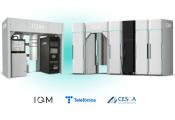New EuroHPC Quantum Computer To Be Hosted in the Netherlands
October 22, 2024 -- Today, at the EuroHPC User Day 2024 in Amsterdam, the EuroHPC Joint Undertaking announced the selection of SURF to host and operate a new European quantum computer, in coordination with QuantumDelta NL. The system will be located at the Amsterdam Science Park and integrated into the Dutch national supercomputer, Snellius.
The quantum system will be based on semiconductor spin qubits and, in its initial phase, will offer a minimum of 16 physical qubits. Semiconductor spin qubit technology holds great potential for large-scale quantum information processing, primarily due to the qubits' smaller physical size, which allows for high scalability. A key advantage of this approach is Europe's well-established semiconductor industry, which is positioned to play a pivotal role in the mass production of quantum chips. Leveraging Europe's existing infrastructure and expertise, there is strong potential for scaling up manufacturing capabilities to meet future demand as the technology matures.
Semiconductor spin-qubit technology is not yet under deployment in any other EuroHPC quantum computers. This technology will complement the EuroHPC quantum computing ecosystem currently being developed, and aligns with EuroHPC JU’s goal of providing European users with access to a diverse range of quantum computing platforms.
Supercomputers with quantum computing acceleration can solve specific complex tasks in seconds, tasks that traditional supercomputers struggle to compute. They are particularly powerful for problems that involve complex mathematical calculations or optimisation challenges such as improving traffic flows in smart cities or simulating molecular structures, critical for the development of new drugs and materials. Other potential applications include accelerating climate modelling to predict weather patterns more accurately, and enhancing cryptographic algorithms for better cybersecurity.
This new EuroHPC quantum computer will support research and innovation and will be available to a wide range of European end-users, spanning from the scientific community to industry and the public sector. It will drive innovation across Europe while positing our continent as a frontrunner on this cutting-edge technology.




































